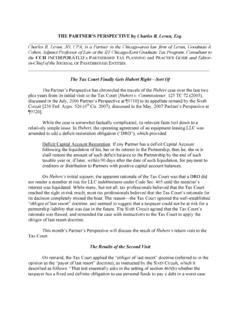Transcription of Sales vs. Redemptions of Partnership Interests
1 Sales vs. Redemptions of Partnership Interests Follow the yellow brick road? Often, when a partner of a Partnership is going to depart, there may be a choice as to whether the remaining partners will purchase the departing partner s interest on a pro rata basis or whether the Partnership will redeem the interest . Under either approach, the departing partner ultimately will wind up with the same amount of proceeds and the remaining partners will wind up with the same percentage ownership interest in the Partnership after the departure. However, depending on which road the parties take, the ultimate tax results can differ based on various detours along the way, and there can be visits with monkeys, poppies and even the wizard himself.
2 This article is a think piece for practitioners to consider when choosing between a sale and a redemption of a Partnership interest , in situations in which the choice is there for the taking. It will discuss some of the issues to consider both from the departing partner s perspective and that of the remaining partners and the Partnership . Readers may be surprised at some of the tax differences, particularly timing differences, that may result based on which road is taken. Basic Framework for Discussion For purposes of this article, we are going to consider the situation where Toto, Dorothy and the Wizard are equal members of Kansas LLC, a financial consulting firm.
3 Toto has decided he wants to go for a run and retire at a time when the LLC has the following balance sheet: BASIS VALUE Cash $ 100,000 $ 100,000 Cash-basis accounts receivable 0 450,000 FF&E (original cost $400,000) 90,000 150,000 Building (original cost $2,000,000) 800,000 2,690,000 Intangible value 0 1,200,000 $ 990,000 $4,590,000 Mortgage debt $1,590,000 $1,590,000 Members capital accounts (600,000) 3,000,000 $ 990,000 $4,590,000 It is proposed that Toto be paid for his $1,000,000 interest in the LLC by means of the LLC borrowing $500,000 against the equity in the building and distributing such funds on retirement.
4 The balance will be paid in five equal annual installments of $100,000 each, which the LLC expects to be able to pay from earnings. Toto and the LLC are analyzing the various choices of structuring the transaction and the tax implications to all parties of such choices. At the outset, note that Toto s total income recognition (whether his interest is sold or redeemed) on the transaction eventually will be $1,200,000: Cash consideration (including deferred payments) $1,000,000 2 Liability relief (1/3 of $1,590,000) 530,000 Total amount realized 1,530,000 Basis: Negative capital account $ (200,000) Share of mortgage (1/3 of $1,590,000) 530,000 330,000 Gain $1,200,000 The $1,200,000 of gain will be attributable to the following items (ignoring any potential imputation of interest in the case of a sale or exchange, as discussed below).
5 Ordinary income items: Cash-basis accounts receivable $ 150,000 FF&E recapture 20,000 $ 170,000 Capital gain items: Potential section 1250 capital gain (1/3 of $1,200,000 depreciation taken): $ 400,000 Remaining capital gain on building 230,000 Gain on intangible value 400,000 1,030,000 $1,200,000 As noted above, in many circumstances, there is little or no difference in the economic consequences between a sale or a redemption of a Partnership interest . For example, under the foregoing facts, whether Toto s interest is sold in equal pieces to Dorothy and the Wizard or whether the LLC redeems Toto s interest , Dorothy and the Wizard wind up as equal members.
6 However, there are numerous differences in the tax consequences of the exit transaction, depending on whether the transaction is structured as a sale or a redemption of Toto s membership interest . If the parties desire to structure the transaction as a sale or exchange of a membership interest , the form of the transaction generally will be respected by the IRS. On the other hand, if the parties desire to structure the transaction as a redemption of a membership interest , the form will not always be respected, as the IRS may attempt to recharacterize the redemption as a disguised sale of a Partnership interest . The Disguised Sale Rules The place to start in the analysis of the tax differences between a sale and a redemption of a Partnership interest is to determine whether, if the parties structure the transaction as a redemption as described above, the transaction will be respected as such for federal income tax purposes.
7 The determination of whether the transaction is respected as a redemption is a function of whether the disguised sale rules of Code Sec. 707(a)(2)(B) would apply to recharacterize the redemption as a sale or exchange of a Partnership interest . Code Sec. 707(a)(2)(B) has been in the Code since 1984. In its most elementary form, the disguised sale rules can recharacterize a contribution of appreciated property to a Partnership followed by a distribution of other 3 Partnership property to the contributing partner as a disguised sale of the contributed property, rather than as tax-free Partnership contribution and distribution transactions. Treasury issued fairly comprehensive and complicated regulations under Code Sec.
8 707(a)(2)(B) (the Disguised Property Regulations ) on September 25, 1992. However, Reg. , which is entitled Disguised Sales of Partnership Interests , was reserved. That is not to say that the IRS did not believe that a contribution to an existing Partnership combined with a distribution to an existing partner could not be recharacterized as a sale of a Partnership interest before any regulations were issued. In fact, several years ago, the IRS issued a few private letter rulings determining that a disguised sale of a Partnership interest had occurred. See, , FSA 200024001 and TAM 200037005. The reason for the more than 20-year delay in the issuance of proposed regulations addressing disguised Sales of Partnership Interests likely is the complexity in distinguishing between what should be a tax-free property contribution/distribution transaction and what should be considered a disguised sale of a Partnership interest .
9 The Senate Finance Committee Report ( Report ) relating to the Tax Reform Act of 1984 (at CCH p. 831) indicated that Congress anticipated that such regulations would be issued: It is anticipated that the regulations will apply the provision when the transfer of money or other property from the Partnership to the partner is related to the transfer of money or other property to the Partnership in such manner that, taking into account all the facts and circumstances, the transaction substantially resembles a sale or exchange of all or part of the property (including an interest in the Partnership ). (Emphasis added.) However, the Report also contained the following caution: In prescribing these regulations, the Treasury should be mindful that the committee is concerned with transactions that attempt to disguise a sale of property and not with non-abusive transactions that reflect the various economic contributions of the partners.
10 Similarly, the committee does not intend to change the general rules concerning the tax treatment of the partners under sections 721, 731, and 752 to the extent (1) contributed property is encumbered by liabilities not incurred in anticipation of the contribution, or (2) contributions to a Partnership which, because of liabilities of the Partnership incurred other than in anticipation of the contribution result in a deemed distribution under sec. 752(b). On November 26, 2004, Treasury finally issued proposed regulations addressing disguised Sales of Partnership Interests (the Proposed Regulations ). Despite Congressional warning, the Proposed Regulations create a framework that may call into question vanilla property contribution/distribution transactions.







